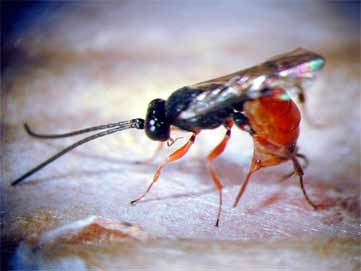Although they differ from predators and parasites, parasitoids are important in pest suppression.
Unlike predators, parasitoids do not kill their host immediately, and unlike parasites, they do eventually kill their host.
Parasitoid wasps and flies have been keystone agents in biological control, in part, because of their specialization on certain pest families and species.
Their life histories inspire science fiction. They are cryptic insects, but upon close observation, they can be found everywhere.
You don’t have to look far to find parasitoids
Having a keen eye for a healthy versus parasitized insect is key.
Identifying features include parasitoid exit holes or exposed parasitoid larvae and pupae.
Aphid populations on many plants can be teeming with aphid parasitoids.
Parasitized aphids (also called ‘mummies’) will have a bulbous appearance, straw-like or sometimes black colour, and adult parasitoid exit hole.
Of the several parasitoids released against alfalfa weevil in Utah, only one, Bathyplectes curculionis, has become well established. The pupal case of the weevil parasitoid is quite distinct with a white stripe.
One of the more noticeable parasitized hosts is the tomato hornworm that when parasitized by a Braconid wasp, has multiple white pupal cases on its outer body.
Wheat growers that have to deal with cereal leaf beetle may be familiar with the resident larval parasitoid, Tetrastichus julis or Tj for short, which aids in extensive beetle suppression.
Conserve parasitoid populations
It is important to conserve these beneficial parasitoids by avoiding broad-spectrum insecticides whenever possible, and planting nectar-producing plants for the adults.
In smaller settings or enclosed areas such as backyard gardens, greenhouses, or high tunnels, parasitoids may be purchased and released to aid in pest management.
Host specificity
Note that each parasitoid is specific to a particular family of insects or to a single species.
In addition to their host specificity, the parasitoid also deposits eggs in or on specific life stages (egg, larva, pupa, or adult) of the insect host.
So matching up the parasitoid with the proper pest type and life stage is important for their success.
For example, Trichogramma wasps primarily attack the egg stage of various insects.
Ready-to-use dispensers
Parasitoids are conveniently sold in ready-to-use dispensers such as a shaker bottle or a card that hangs on a plant stem.
They are shipped with cool packs and can be immediately applied or briefly stored according to directions.
Contact Russell Fox
email:
For information, see Tree Fruit October 2014




















